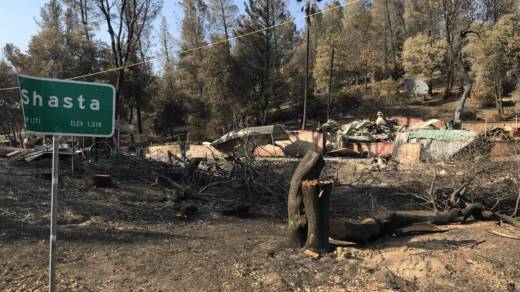In response to California’s deadly wildfires, the Trump administration is calling for more ‘active’ logging in western forests. They want to open up more public lands to the timber industry, to reduce the fire risk but also revive rural, natural-resource dependent economies.
This is a decades-old debate in the West and by no means a new GOP talking point. But out on the ground, foresters and even some timder industry leaders say what’s really needed to mitigate the wildfire threat is a lot more involved — and expensive.
“The picture has changed,” says Rich Fairbanks.
Fairbanks managed and fought fires for the U.S. Forest Service for 30 years, largely in southern Oregon and northern California, where many of the West’s worst fires have burned so far this year. Fairbanks is now a fire and forest management consultant from his home near Ashland, Ore.
“A lot of senators and congressmen are still thinking we’re back in the 1970s,” he says.
Indeed, much has changed since the 1970s and 1980s, which marked the height of the timber wars over clear cutting and the spotted owl. Since then, the amount of federal land open to logging has dropped precipitously and a lot of the logging moved to private land. Timber and logging companies themselves have consolidated and mechanized, leaving fewer people necessary to do the work.
A ‘Sustainable’ Industry
So, even if more public land was opened back up to logging, retired Forest Service officials like Bill Oliver wonder whether there is enough industry left in the West to process the timber. Oliver, a wildfire scientist, says the forests are dangerously overgrown today due to prior forest management decisions.
“The forests are much too dense because we’ve tried to keep fire out for about a hundred years,” Oliver says.
Oliver says the actual stuff that needs to be cleared out of the woods are the brush and small diameter trees that provide kindling for today’s mega fires. Those don’t tend to be worth that much to the timber industry. It’s the big trees that make the money. This has long been an impediment to joint public-private forest restoration and wildfire mitigation efforts. But there are signs this is changing.
One of the few big players left in northern California’s wood products industry is Sierra Pacific Industries. Each of their six mills in the region are being systematically upgraded to handle that smaller diameter wood so it can be turned into commercially viable products like particle board.
The industry sees opportunity, says Dan Tomascheski, vice president of forest resources at the company. But they need reassurances that there will be a lumber supply on public lands for more than just one or two years.
“This can’t be a bubble,” he says. “This has to be a ramp up and then a sustained program.”
The Forest Service says there is a sustainable market — and opportunity — when you consider that upwards of 80 million acres of forest lands nationwide are considered at risk of major fires and in need of treatment. So far only about two million acres of public land have been treated through logging and other thinning projects or prescribed burns, according to the agency.
“We’re not talking about just cutting trees to cut trees,” says Tomascheski. “We’re talking about harvesting timber in a way that produces the fuel breaks and the thinning that we all need.”
Environmental Appeals
The Trump administration says the biggest thing standing in the way of the fuel load is environmental lawsuits. A bill introduced this month by Sen. Steve Daines, R-Mont., aims to reduce legal appeals and fast track forest management projects on some national forests in the West.
At a recent committee hearing, Daines said there were more than two dozen forest management projects under litigation in Montana alone.
“I can’t even see the mountains out of my backdoor in my home which are just a few miles away because of the smoke,” Daines said.
The administration’s secretary of the interior, Ryan Zinke, has even referred to some of the groups opposing logging as environmental terrorist organizations, causing an outcry in many corners of the region. Still, in a lot of the West, tensions between environmentalists and logging companies have actually cooled over the past decade.
There are now partnerships and compromises being made on forest health projects from Idaho to California that don’t always make the headlines. Dan Tomascheski at Sierra Pacific says his company now regularly talks with some environmental groups that he couldn’t imagined working with 20 years ago. “The level of hostility and the fiery dialogue has really diminished,” Tomascheski says. He says this is largely due to an understanding among all sides that the status quo in forest management isn’t working and the wildfires are only worsening in severity.
People outside of Washington D.C. tend to point their finger at a much less high profile culprit they say is holding up fire mitigation projects: funding.
“The biggest enemy of good forest management, especially fire management, is budget cuts,” says forest management consultant Rich Armstrong.
Armstrong says it takes money to plan and implement the kinds of landscape level forest restoration projects that are needed. But the government has cut the budget for wildfire mitigation and other forest programs, while diverting much of the remaining funding to pay to fight wildfires.
At Sierra Pacific, Dan Tomascheski sees the effects of this on the ground.
“The Forest Service has lost quite a bit of expertise in all of the disciplines of hydrology, road engineering, wildlife biology etcetera,” he says. “They’ve lost a lot of the funding for those positions and they need to regain some of that expertise.”

9(MDAxOTAwOTE4MDEyMTkxMDAzNjczZDljZA004))